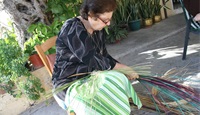
Applicant:
Cyprus Architectural Heritage Organisation, Akrotiri Community Council, Akrotiri Environmental Education Centre
Communities Concerned - Bearers of the element:
Cyprus Architectural Heritage Organisation, Akrotiri Environmental Education Centre, Traditional crafts-persons (basket-weavers)
Domain of Intangible Cultural Heritage:
Traditional craftsmanship
Date of inscription:
2017
Geographical distribution:
The identity of the Akrotiri community is directly associated with the craft of soft basket-weaving due to the Akrotiri grassland and salt-lake. At the same time, basket-weaving constituted the main occupation of Akrotiri inhabitants and with the products they sold they could secure a living. They used to collect their raw materials from the area, as native rushes, grasses, prickly shrubs, canes or reeds such as “rousouthkia”, “samadji”, “chondros”, “sklinidji” and “floudi” were in abundance in the Akrotiri grassland and have been providing for centuries the necessary materials to the crafts persons. Other areas where soft basket-weaving is identified with the large pack baskets loaded on the backs of donkeys to carry different products, so called «syrizades”, were the Lakatamia, Deftera, Kalo Chorio Larnaca and Livadia areas.
Brief description:
The term “soft basket-weaving” defines the craft of making a specific group of baskets (baskets, “talaria” i.e. baskets used in the cheese-making process) bags of different types and sizes, street sweepers – “froukalia”, pack baskets called “syrizes”, smaller baskets for packed lunches called “korokolioi”, weave string-like trays hanging from the beams to store bread called “tapatzia”, straw-mats and flat straw baskets called “zembilia”. This craft is also associated with the use of the woven cord to make traditional chairs (so-called “tonenes” chairs) apart from baskets.
The Akrotiri salt-lake and grassland is one of the most important wetlands in the Eastern Mediterranean, renowned both for its flora and its fauna. In this grassland the inhabitants can find the raw materials they need for basketry, a craft which is directly associated with the identity of the Akrotiri community. Soft basket-weaving constituted the main occupation of Akrotiri inhabitants for years and with the products sold they managed to secure a living. Both men and women knew the craft of basketry and made useful objects, necessary for the everyday traditional rural life in Cyprus. These objects were transported on donkeys’ backs crossing the salt-lake through an area called Kourtellin all the way to Limassol to be sold at markets.
Specific types of grasses (11 plant species) were used, which were harvested usually during the summer months. The plants would be left in the sun to dry for 6-7 days and then stored in special areas and used throughout the winter months. In order to make the fibres soft enough to be able to be woven, they had to be soaked overnight in water. In some cases, such as for example in making the “talaria” baskets used in the cheese-making industry, fresh pinweed plant would also be used to make the bases.
The main basketry products are baskets (of different sizes depending on the needs and uses): “talaria” baskets (used to strain the cheese), woven basket-bags or “tsentes” (in different sizes for transporting agricultural produce), “froukalia” (small usually hand-held brooms), “syrizes” (two large back baskets connected in the middle and placed on the donkeys’ backs to transport products), “korokolios” (a container for storing and transporting foodstuffs or packed lunches), “tapatzia” (a flat tray-like basket hanging from the ceiling to store bread and other bakery products), a traditional straw-mat, the “zembili” (baskets used during sowing seeds or harvesting olives) and woven bottle-covers (used to protect the wine demijohn type of containers).